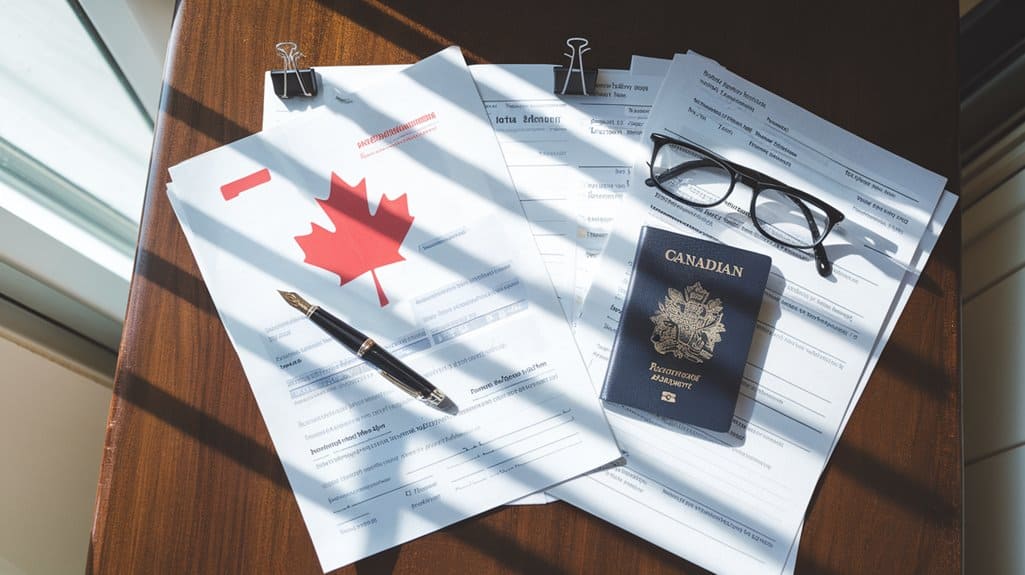
You’ll need an Authorization to Return to Canada (ARC) if you’ve received a removal order and want to re-enter before your prescribed period ends. The application process varies based on your removal order type: departure orders don’t require ARC if you left within 30 days, exclusion orders need a one-year wait, and deportation orders always require ARC. Your application must include detailed documentation, photos, and a processing fee. Understanding the specific requirements for your situation will greatly impact your success.
Understanding ARC Requirements and Eligibility
When you’re considering returning to Canada after receiving a removal order, understanding whether you need an Authorization to Return to Canada (ARC) depends on your specific situation.
Navigating the requirements for re-entering Canada starts with understanding your removal order and whether you need ARC authorization.
The type of removal order you received determines your requirements. If you’ve received a departure order and left Canada within 30 days with a verified departure, you won’t need an ARC.
For exclusion orders, you’ll need to wait one year before returning without an ARC. However, if you’ve received a deportation order, you must apply for an ARC before attempting to return.
You’ll need to provide detailed documentation, including a completed Temporary Resident Visa application form, passport photos, and a letter explaining your reasons for return.
The application must address the circumstances that led to your removal and demonstrate positive changes since then.
Types of Removal Orders That Affect Your ARC Application
Understanding the specific type of removal order you’ve received directly impacts your ARC requirements and application process. Each order carries different conditions and requirements for returning to Canada, which you’ll need to carefully consider when preparing your application.
- Departure Orders require no ARC if you leave within 30 days and verify your departure, but failing to do so converts it to a deportation order.
- Exclusion Orders don’t require an ARC if you stay away for one year, though early return needs one.
- Deportation Orders always require an ARC application before any return attempt.
- Misrepresentation cases under Exclusion Orders result in a five-year ban, requiring careful documentation in your ARC application.
These distinctions determine your application strategy and the supporting documentation you’ll need to provide.
Essential Documents for Your ARC Submission
A complete and properly organized document package forms the foundation of a successful ARC application.
You’ll need to submit a completed Temporary Resident Visa Application Form, along with two recent passport-size photographs and your valid passport.
Include a detailed letter that explains your reasons for wanting to return to Canada and your future plans.
You must also provide supporting documents that strengthen your case, such as proof of ties to your home country, evidence of changed circumstances since your removal, and documentation addressing the original reasons for your removal order.
If your departure order escalated to a deportation order, you’ll need to explain why you didn’t leave within the required timeframe.
Don’t forget to include proof of payment for the non-refundable processing fee.
Step-by-Step Guide to Filing an ARC Application
Filing an ARC application requires careful attention to detail and a systematic approach to guarantee you don’t miss any essential steps.
A meticulous and organized process is essential when filing your ARC application to ensure all requirements are properly met.
You’ll need to begin by gathering all required documents and completing the Temporary Resident Visa application form accurately. Pay special attention to explaining your circumstances and reasons for wanting to return to Canada.
- Complete the application form with current personal information and details about your removal order
- Write a detailed letter explaining why you left Canada, your current situation, and your future plans
- Include supporting documentation that proves positive changes in your circumstances since the removal
- Submit your application with the processing fee and proof of payment for any removal-related expenses
Remember to keep copies of everything you submit and follow up on your application’s status through proper channels.
Processing Times and Application Fees
When submitting an Authorization to Return to Canada application, you’ll need to account for both processing times and associated fees, which vary depending on your specific circumstances and application type. You can expect to pay a non-refundable processing fee, and if the government covers your removal costs, you’ll need to repay those expenses before approval.
| Application Type | Processing Time | Fee (CAD) |
|---|---|---|
| Standard ARC | 3-6 months | $400 |
| Urgent ARC | 2-4 weeks | $400 + $100 |
| Complex Cases | 6-12 months | $400 |
Your processing time may be longer if your application is incomplete or requires additional documentation. Keep in mind that paying the fee doesn’t guarantee approval, and you’ll need to submit a new payment if you reapply after a rejection.
Factors Immigration Officers Consider When Reviewing ARCs
Immigration officers evaluating Authorization to Return to Canada applications focus on several critical factors to determine whether you’ll be allowed re-entry into the country.
They’ll carefully assess your circumstances, history, and future intentions before making their decision.
- The amount of time that’s passed since your removal order and whether you’ve demonstrated changed behaviour or circumstances
- Your specific reason for wanting to return to Canada and whether it’s compelling and well-documented
- Any criminal history or immigration violations, including the original reason for your removal
- Your ties to both Canada and your home country, including family connections, job prospects, and property ownership
The assessment aims to guarantee you won’t repeat past violations and that you’ll comply with Canadian immigration laws during your stay.
Common Reasons for ARC Application Rejections
Despite careful preparation, many Authorization to Return to Canada applications get rejected due to common mistakes and oversights that applicants make during the submission process.
You’ll face rejection if you submit incomplete documentation, fail to provide a detailed explanation of your removal circumstances, or don’t demonstrate significant changes in your situation since the removal order.
Your application won’t succeed if you can’t prove you’ve addressed the original reasons for your removal, haven’t repaid deportation costs to the Canadian government, or fail to provide concrete evidence of ties to your home country.
Addressing past removal issues, paying deportation costs, and proving home country connections are crucial for Authorization to Return to Canada approval.
Additionally, you’ll receive a rejection if you don’t clearly justify your need to return to Canada or if your application contains inconsistent or misleading information about your immigration history.
Special Circumstances That May Impact Your ARC Status
Several unique circumstances can greatly affect your Authorization to Return to Canada status and application process.
Your current situation might require special consideration, particularly if you’re dealing with humanitarian cases, family obligations in Canada, or emergency situations. Understanding these circumstances can help you better prepare your application and improve your chances of approval.
- Medical emergencies involving immediate family members in Canada may expedite your ARC processing.
- Ongoing legal proceedings where your presence is required might influence the decision.
- Humanitarian grounds, such as seeking medical treatment only available in Canada.
- Changes in your home country’s political situation that affect your safety.
These special circumstances should be thoroughly documented in your application with supporting evidence from relevant authorities or professionals.
How Canadian Currents Immigration Can Help
Professional guidance through the ARC application process is available from Canadian Currents Immigration’s dedicated team of legal experts.
Our experienced immigration lawyers, consultants, and paralegals will work closely with you to develop a tailored approach for your specific situation. We’ll help you navigate the complex requirements, ensuring all necessary documentation is properly prepared and submitted.
Expert guidance and personalized support to navigate complex immigration requirements, with meticulous attention to documentation and submission processes.
You’ll benefit from our decades of combined experience in immigration law as we assist you with preparing your detailed explanation letter, gathering supporting documents, and addressing any concerns related to your removal order.
We recognize the nuances of ARC applications and will work efficiently to present your case in the most favourable light while maintaining cost-effectiveness throughout the process.
Frequently Asked Questions
Can I Apply for ARC While Still Inside Canada?
You can’t apply for ARC while inside Canada. You must leave Canada first and apply from outside the country after receiving your removal or deportation order.
What Happens if My ARC Application Is Approved but I Don’t Travel?
If your ARC is approved but you don’t travel, you won’t lose the authorization. You can use it later when you’re ready to enter Canada, as it’s a one-time approval.
Can Family Members Be Included in My ARC Application?
You can’t include family members in your ARC application. Each person who needs an ARC must submit their own separate application and pay individual processing fees.
Is an Interview Required During the ARC Application Process?
You won’t typically need an interview for your application. However, an immigration officer may request one if they need additional information to make their decision.
Can I Expedite My ARC Application in Emergency Situations?
You can’t officially expedite your ARC application. While you can explain your emergency in a letter to immigration officials, they’ll still process applications in the order received.
Conclusion
Your ARC application’s success depends on thorough preparation and attention to detail. If you’re planning to return to Canada after removal, make certain you’ve settled any outstanding fees, gathered all required documents, and crafted a compelling explanation for your circumstances. While obtaining an ARC doesn’t guarantee entry, a well-prepared application greatly improves your chances. Consider seeking professional guidance to navigate this complex process effectively.

We serve ALL of Canada. Currently have offices Western Canada — Vancouver, Calgary, Edmonton, Kamloops and Red Deer. We also have the infrastructure to work with any of our clients virtually — even from the furthest regions of the Yukon to Newfoundland.
Call (778) 331-1164 [toll free 1 (844) 715-0940] to get routed to the best office for you or contact us online to schedule an appointment.
We also have a dedicated intake form to help you get the ball rolling. Our intake team will review your specific case and advise you on the next steps to take as well as what to expect moving forward.
Our offices are generally open 8:30 a.m.—4:30 p.m., Mon—Fri.

Alfonso Chen
IMMIGRATION LAWYER
Alfonso is a lawyer of our Vancouver office who provides services in both English and Mandarin. Prior to joining our firm, he worked at a full-service law firm for over four years, where he helped clients with a wide variety of family law matters, from drafting prenuptial agreements to negotiating terms for and drafting separation agreements to representing clients for divorces.



